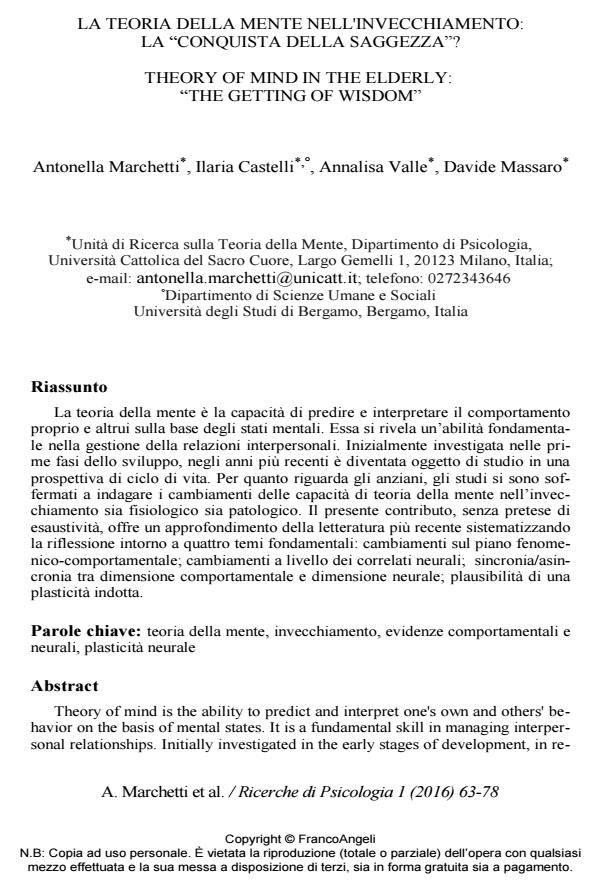La teoria della mente nell'invecchiamento: la "conquista della saggezza"?
Titolo Rivista RICERCHE DI PSICOLOGIA
Autori/Curatori Antonella Marcheti, Ilaria Castelli, Annalisa Valle, Davide Massaro
Anno di pubblicazione 2016 Fascicolo 2016/1
Lingua Italiano Numero pagine 16 P. 63-78 Dimensione file 78 KB
DOI 10.3280/RIP2016-001005
Il DOI è il codice a barre della proprietà intellettuale: per saperne di più
clicca qui
Qui sotto puoi vedere in anteprima la prima pagina di questo articolo.
Se questo articolo ti interessa, lo puoi acquistare (e scaricare in formato pdf) seguendo le facili indicazioni per acquistare il download credit. Acquista Download Credits per scaricare questo Articolo in formato PDF

FrancoAngeli è membro della Publishers International Linking Association, Inc (PILA)associazione indipendente e non profit per facilitare (attraverso i servizi tecnologici implementati da CrossRef.org) l’accesso degli studiosi ai contenuti digitali nelle pubblicazioni professionali e scientifiche
La teoria della mente è la capacità di predire e interpretare il comportamento proprio e altrui sulla base degli stati mentali. Essa si rivela un’abilità fondamentale nella gestione della relazioni interpersonali. Inizialmente investigata nelle prime fasi dello sviluppo, negli anni più recenti è diventata oggetto di studio in una prospettiva di ciclo di vita. Per quanto riguarda gli anziani, gli studi si sono soffermati a indagare i cambiamenti delle capacità di teoria della mente nell’invecchiamento sia fisiologico sia patologico. Il presente contributo, senza pretese di esaustività, offre un approfondimento della letteratura più recente sistematizzando la riflessione intorno a quattro temi fondamentali: cambiamenti sul piano fenomenico- comportamentale; cambiamenti a livello dei correlati neurali; sincronia/asincronia tra dimensione comportamentale e dimensione neurale; plausibilità di una plasticità indotta.
Parole chiave:Teoria della mente, invecchiamento, evidenze comportamentali e neurali, plasticità neurale
- Assessing metarepresentational abilities in adolescence: an exploratory study on relationships between definitional competence and theory of mind Alessia Cornaggia, Federica Bianco, Ilaria Castelli, Carmen Belacchi, in Frontiers in Psychology 1456432/2024
DOI: 10.3389/fpsyg.2024.1456432 - Humanity in Psychology Antonella Marchetti, Edoardo Alfredo Bracaglia, pp.179 (ISBN:978-3-031-30639-6)
Antonella Marcheti, Ilaria Castelli, Annalisa Valle, Davide Massaro, La teoria della mente nell'invecchiamento: la "conquista della saggezza"? in "RICERCHE DI PSICOLOGIA " 1/2016, pp 63-78, DOI: 10.3280/RIP2016-001005